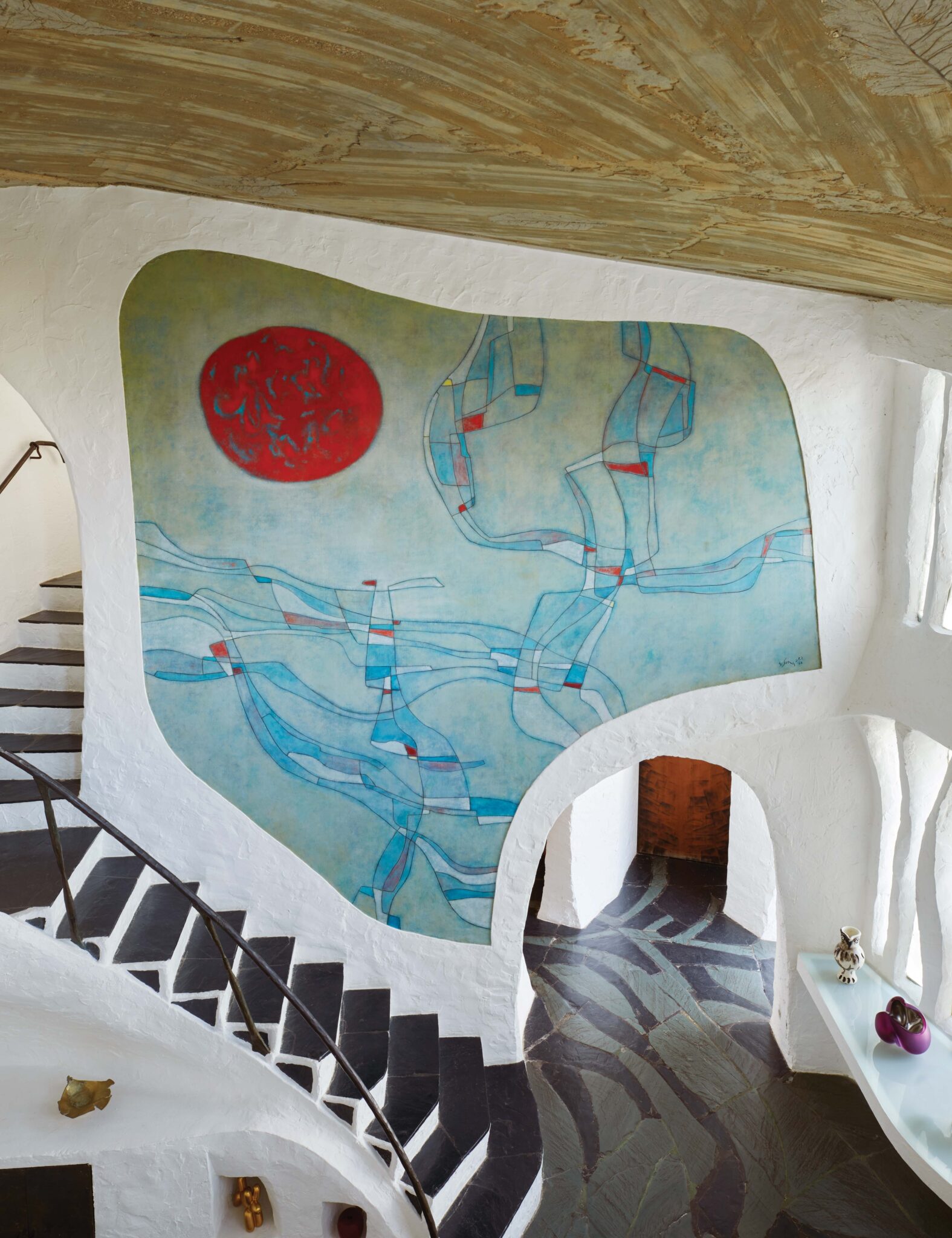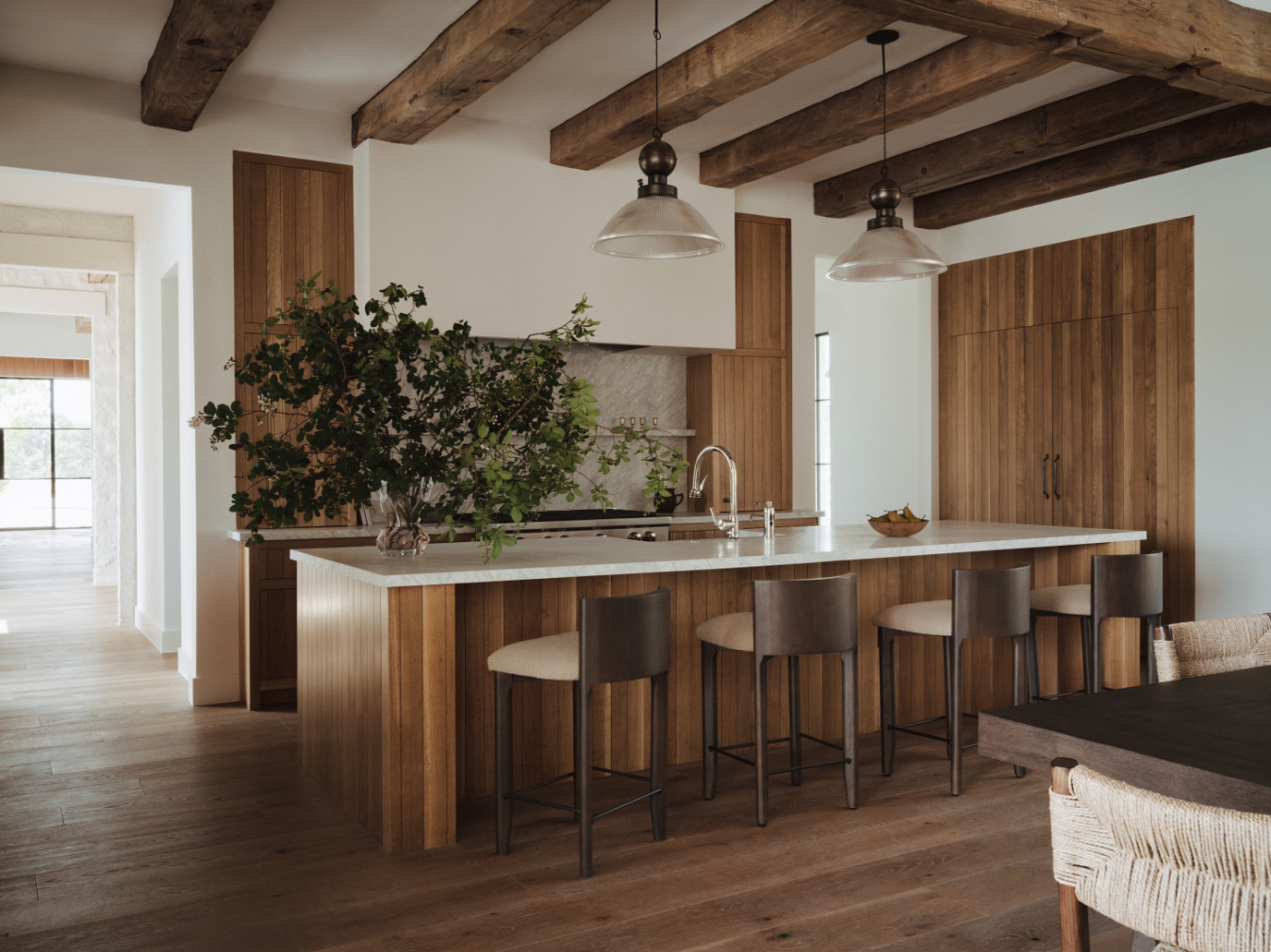It’s a thing decorators say all the time: Buy what you love, and you’ll find a place for it. What the pros don’t always explain is that keeping an attic filled with every whatnot you ever went gaga for until the shining moment that that tramp art mirror or gilt palm frond pilaster finally gets its spotlight requires patience—and a lot of trial and error. Connecticut-based designer Charlotte Barnes is a buy-what-you-love tub-thumper, so when she and her husband downsized from a rambling five-bed- room farmhouse to a three-bedroom charmer of a carriage house in Fairfield County, she stylishly put her money where her mouth is.

Barnes’s Connecticut living room had long, challenging proportions, so she split it up into a gallery-like space with several seating areas and adjusted the interior architecture—covering up a transom window on the inside while keeping the facade intact—to allow her to hang art, including works by Hayley Matthews (left), Gino Salmaso (center) and Anke Weyer (right). Round table, John Roselli & Associates. Sofa and brass end table, Collection Charlotte Barnes. Folded metal table, Gerald Bland. Matchstick blinds, Hartmann&Forbes.
FRANCESCO LAGNESE-

In another section of the living room, vintage gilt palm frond pilasters were converted into uplights and an African tribal chair is an unexpected—and winning—counterpoint to an iron cocktail table that’s followed Barnes around since she bought it in London in 1986. Mirrored screen, Collection Charlotte Barnes. Art, Sam Glankoff.
FRANCESCO LAGNESE -

A library table in the living room helps define the echoey room and set off accumulated bibelots like a treasured bronze bust from A la Turca House in Istanbul and a miniature painting.
FRANCESCO LAGNESE
“I’m always shopping, and I also have things from my parents and grandparents,” she says of a trove decades in the making that needed to be snipped down for tighter digs. “I had to choose my most favorite objects.” She also had to figure out how best to showboat a lifetime of must-haves into spaces with less-than-ideal proportions. While the house was packed with charisma—soaring ceilings, Dutch doors, a turret!—it also had its pickles, like a long, narrow living room (25 feet by 14 feet) that clobbers you the minute you walk in the door, and upstairs bedrooms angled with eaves.
-

In the dining room, Barnes auditioned several tables before settling on this 1940s French version, which she paired with chairs of her own design. Because she couldn’t find a pendant with the right proportions, she had a basket converted into one as a placeholder, but liked it so much it became a permanent fixture.
FRANCESCO LAGNESE -

A built-in cabinet in the dining room displays glassware and porcelain that Barnes has collected and inherited from her mother and grandmother.
FRANCESCO LAGNESE
Barnes, who has the gumption of an inveterate hunter and gatherer, didn’t bat a single eyelash. Take the living room. “I must have rearranged it 15 times,” she says. What she nudged into existence is a gallery-like space, dotted with welcoming seating arrangements (there’s a reason she calls it the party room), where roller-coaster legs on a painted Italian cocktail table banter with sharp-limbed nesting tables of her own design and a clever folded metal piece that’s another end table in theory, but looks like an art installation in practice. “I took all the sculptural things that had been spread out in the other house and put them together here,” she notes. The geometry of the chevron-patterned floors she installed plays off of those sculptural edges, while their finish gives the space a bright luminosity.

The family room is a mélange of rich colors and textures and purposely mismatched objects like an antique English walnut table and a plainspoken, Swedish-style painted piece from her own collection. “I wanted something sober to bring down all that glitter,” says Barnes. Painted end table, Collection Charlotte Barnes. Lamps, Christopher Spitzmiller. Art, Shelley Hesse.
FRANCESCO LAGNESE-

A tramp art mirror that Barnes had in storage became the unlikely centerpiece of a powder room that also features a painted antique dresser-turned-vanity.
FRANCESCO LAGNESE -

Friend and landscape designer Martha Baker helped Barnes define her large porch with trellises that create sheltered outdoor rooms; seating, vintage Salterini; table, RT Facts.
FRANCESCO LAGNESE
But with all those hard lines, she risked obscuring those room’s curves. “It was feeling very handsome, but quite severe. Also, the suzani pattern on the curtains screamed for something else soft,” says Barnes. Out from her batwing caftan sleeves Barnes pulled a standby trick: wallpapered ceilings. “They’re a great way to jazz up a space,” she explains. “This one’s a painterly marbleized pattern that just made the room. Even though there are lots of traditional pieces in there, the push and pull made it feel modern. It’s traditional but not. The overall affect is timelessness.” And personal. If a house is a biography, this story could be no one else’s but hers.

Custom lampshades on the Circa Lighting sconces in the main bedroom pull out a motif from the headboard and window shade fabric and nudge the room in a contemporary direction; the wild card is the bench fabric, which keeps the scheme from getting too matchy-matchy: “It’s the unusual thing that goes into the room that you don’t think would work but does.” Bedding, Pratesi and Leontine Linens. Bedside table, Chelsea Editions. Art, Wayne Pate
FRANCESCO LAGNESE-

A vintage painted screen in the corner of the main bedroom functions like art in a space where eaves would make hanging pieces difficult; lampshade, Irving & Morrison.
FRANCESCO LAGNESE -

“I could wrap a whole house in antelope,” says Barnes of the rug in her dressing room, which also features a skirted vanity she found years ago in Bermuda; the pendant is a 1940s French shade she had converted into a ceiling fixture; monogrammed pillow, Rebecca Vizard.
FRANCESCO LAGNESE
In fact, you can see a direct correlation between the boho-chic caftans that Barnes favors and the pattern-on-pattern maximalism on display in the family room. “For as long as I can remember, I’ve wanted a room like the one Renzo Mongiardino did for Lee Radziwill,” she says, referencing the iconic 1960s drawing room in which the walls were completely stitched over in printed Indian textiles. Barnes eventually homed in on a vivid cotton print swirling with paisleys and arabesques to cop the look. “Even my wallpaper guy was like, ‘Are you sure? It’s a lot.’” She was uncowed, knowing that the large scale of the pattern would update the aesthetic and breathe fresh life into her vintage and antique pieces. So she was off to the races, adding in a swirl of elements— Christopher Spitzmiller lamps with placeholder shades from storage that ended up staying for good; rich velvets, linens and flannels in solid colorways; antlers; art; heirlooms—to make it her own and a family-favorite destination. “It’s the heart of the house.”
It’s also a lesson in the rewards of dragging home the things that enchant you and playing the long game. “You can put a million things on a CAD drawing and fill a storage unit with everything in the plan, but when it comes to install, sometimes the chair you meant for the living room works better in the master bedroom and if you have the oddball pieces you bought only because you fell in love with them, then you can move things around,” the designer says. “You have to leave room for the ineffable, the surprise. I don’t like to just fill a room. That’s too easy. I would rather wait for perfection— even if it’s imperfect. That’s how you create spaces with meaning.”
THIS STORY ORIGINALLY APPEARED IN THE SPRING 2022 ISSUE OF FREDERIC. CLICK HERE TO SUBSCRIBE!






















